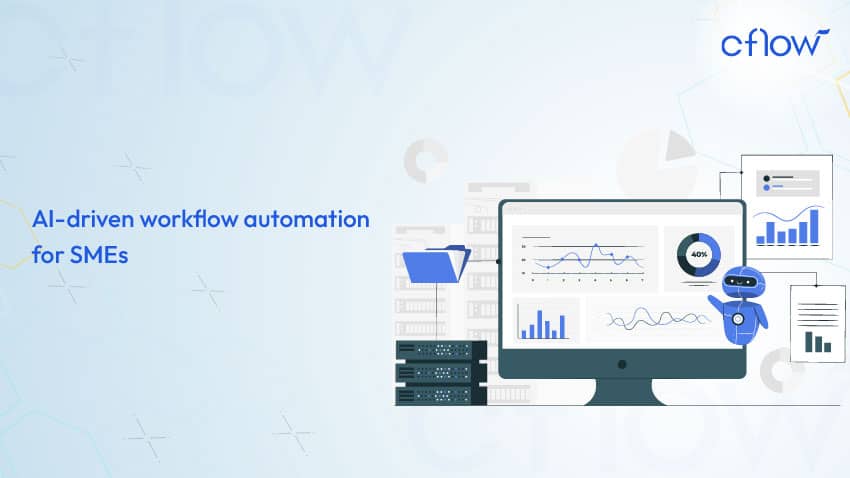AI-Driven Workflow Automation for SMEs

Key Takeaways
- AI workflow automation helps SMEs streamline operations, reduce delays, and improve efficiency using limited resources and minimal supervision.
- Automation tools eliminate repetitive tasks, increase accuracy, and allow employees to focus on strategic growth and high-value initiatives.
- Digital workflow transformation empowers SMEs to adapt quickly to market changes, boosting resilience and competitiveness in evolving industries.
- Cflow enables SMEs to automate workflows affordably, combining rule-based systems with AI to deliver intelligent, scalable, and cost-efficient solutions.
The Case for Workflow Automation in SMEs
SMEs are the backbone of the UK economy, contributing £2.4 trillion in turnover and employing 16.7 million people, according to the UK Government’s 2024 Business Statistics. However, limited budgets, lean teams, and time constraints often hinder their ability to innovate. Manual processes—such as data entry, invoicing, or customer relationship management—consume valuable time and resources, diverting focus from strategic growth.
Workflow automation for SMEs addresses these pain points by leveraging artificial intelligence to streamline repetitive tasks, improve accuracy, and free up human capital for high-value activities. Unlike traditional automation, which relies on rigid rule-based systems, AI solutions for small enterprises use machine learning, natural language processing (NLP), and predictive analytics to adapt to dynamic business needs. For instance, AI can analyse historical data to predict inventory requirements or personalise customer interactions, offering a level of sophistication once reserved for large enterprises.
Why AI-Powered Automation Matters for SMEs
The adoption of AI-powered automation for growing businesses is no longer a luxury but a necessity. Automation and digitisation can lead to a 20–35% increase in productivity for small businesses. Moreover, cost-effective automation for SMEs levels the playing field, enabling smaller firms to compete with industry giants. By automating routine tasks, SMEs can:
- Reduce operational costs: Automation minimises manual labour and errors, saving time and money.
- Enhance scalability: AI tools adapt to growing workloads without requiring proportional increases in staff.
- Improve decision-making: AI-driven insights provide data-backed strategies for market expansion or customer engagement.
- Boost employee satisfaction: Freeing staff from mundane tasks allows them to focus on creative and strategic roles.
Risks of Not Automating: What SMEs Stand to Lose
Sticking with manual processes comes at a high cost in today’s AI-first business environment.
1. Wasted Time
Repetitive tasks drain hours that could be spent on innovation or strategy.
2. Higher Operational Costs
Manual errors, process delays, and inefficient resource usage inflate overheads unnecessarily.
3. Poor Customer Experience
Slower service, missed follow-ups, and disjointed communication lead to lower client satisfaction and lost business.
4. Limited Scalability
Without automation, adding new clients or projects increases the workload linearly—making growth harder and riskier.
5. Missed Insights
Disjointed systems and manual data handling result in lost opportunities for data-driven decisions.
Inaction leads to inefficiencies, rising costs, and a widening gap with competitors who are actively leveraging AI.
Is Your SME Ready for AI Automation?
- Do your teams repeatedly perform the same tasks with minimal variation?
- Are manual approvals or data entries causing bottlenecks and delays?
- Are your employees spending more time on administration than value-added work?
- Do you lack insights due to scattered or siloed data?
- Are you using multiple tools that don’t communicate with each other?
- Do you need to scale but are limited by hiring constraints?
If you answered “yes” to three or more of these questions, it’s time to consider implementing an AI-powered workflow automation solution like Cflow that can empower your team to automate effectively and scale sustainably, without the need for a large IT team.
Industry-Specific Use Cases for SME Automation
Automation delivers tailored value across industries without requiring major infrastructure investments.
1. Retail & E-Commerce
SMEs in retail use AI for inventory forecasting, automated restocking, and personalised promotions. A fashion retailer, for example, can identify trends and automate marketing and logistics accordingly.
2. Consulting & Agencies
Agencies automate proposal creation, client scheduling, and follow-ups using tools like Calendly or PandaDoc—saving hours every week.
3. Healthcare Clinics
AI streamlines patient intake, appointment scheduling, and post-visit engagement, minimising no-shows and improving patient satisfaction.
4. Logistics & Delivery
AI-driven logistics workflows optimise routes, track deliveries in real time, and send status updates, reducing fuel costs and delivery delays.
5. Manufacturing & Distribution
Automation supports quality control, equipment monitoring, and inventory tracking—enabling lean operations and reducing waste.
6. Finance & Accounting
AI automates invoicing, expense reporting, and tax compliance using platforms like QuickBooks and Xero, cutting errors and speeding up month-end processes.
These real-world use cases prove that AI workflow automation can provide fast results with minimal learning curves.
SMEs are Leveraging AI for Competitive Advantage
Small and medium-sized enterprises (SMEs) are moving beyond basic automation by embracing AI for smarter operations, better decision-making, and long-term growth. Here are some of the strategic ways AI is helping SMEs stay agile and competitive.
1. Smarter Customer Service with AI Chatbots
AI-powered chatbots with natural language processing (NLP) capabilities provide 24/7 customer support, reducing response times and improving satisfaction. Personalised interactions also lead to stronger customer relationships and higher retention rates.
2. AI-Powered Cash Flow Forecasting
AI tools analyse historical financial data and external market trends to forecast cash flow more accurately. This helps SMEs anticipate dips, adjust spending, and plan with greater confidence during uncertain periods.
3. Predictive Employee Engagement
By analysing employee feedback and behaviour patterns, AI can detect early signs of disengagement and turnover risk. SMEs can use these insights to take proactive steps that enhance morale and retain top talent.
4. Hyper-Local and Contextual Marketing
AI enables more targeted marketing by analysing location-specific data, customer preferences, and real-time conditions. Tailored campaigns that respond to local trends or behaviours often drive stronger engagement and higher conversions.
5. Real-Time Supply Chain Resilience
AI integrated with connected devices offers real-time visibility into supply chain disruptions. Automated alerts and intelligent recommendations help SMEs respond quickly, maintain continuity, and reduce operational losses.
Benefits of AI-Driven Workflow Automation for SMEs
The adoption of AI-powered automation for growing businesses offers a range of benefits tailored to the unique needs of SMEs. These include:
- Cost Efficiency: AI tools are increasingly affordable, with cloud-based solutions offering subscription models that suit SME budgets. For example, platforms like Zapier start at £15 per month, making automation accessible.
- Time Savings: By automating repetitive tasks, SMEs can save up to 20 hours per week, according to a 2023 study by Zapier, allowing leaders to focus on strategy and innovation.
- Enhanced Agility: AI’s adaptability enables SMEs to respond quickly to market changes, such as shifts in consumer preferences or supply chain disruptions.
- Data-Driven Insights: AI tools provide actionable analytics, helping SMEs identify inefficiencies and opportunities for growth.
End-to-end workflow automation
Build fully-customizable, no code process workflows in a jiffy.
Key Applications of AI Workflow Tools for SMEs
The versatility of AI workflow tools for startups and SMEs makes them applicable across various business functions. Below, we explore key areas where small business process automation is driving tangible results, with real-world examples and insights.
1. Customer Relationship Management (CRM)
Customer satisfaction is a critical driver of SME success, yet managing relationships manually can be overwhelming. AI in small business operations transforms CRM by automating lead scoring, follow-up emails, and customer segmentation.
AI-personalized emails have shown an 82% increase in conversion rates.
2. Financial Management and Invoicing
Financial operations, such as invoicing and expense tracking, are time-intensive for SMEs. Automating business processes in SMEs with AI tools like Xero or QuickBooks streamlines these tasks by automating invoice generation, payment reminders, and tax calculations. A 2024 study by Xero revealed that SMEs using AI-driven accounting tools saved an average of 10 hours per week on financial administration.
3. Human Resources and Talent Management
Recruitment and employee onboarding are resource-heavy processes for SMEs. Digital workflow transformation for SMEs in HR involves AI tools that screen CVs, schedule interviews, and even assess candidate fit through sentiment analysis. Platforms like Workable use AI to reduce hiring time by 40%, according to their 2024 performance metrics.
4. Marketing and Content Creation
Marketing is a critical growth driver for SMEs, but creating personalised campaigns can be resource-intensive. AI automation tools for small businesses like Mailchimp or Canva use AI to generate targeted email campaigns, social media posts, and even visual content. A 2023 report by Mailchimp noted that SMEs using AI-driven email marketing saw a 25% increase in click-through rates.
5. Supply Chain and Inventory Management
Efficient inventory management is crucial for SMEs, particularly in retail and manufacturing. AI solutions for small enterprises use predictive analytics to optimise stock levels, reducing overstocking and stockouts.
AI inventory management reduces logistics costs by 15% and waste by 35%.
ROI-Driven Implementation Roadmap for SMEs
Adopting AI-driven automation doesn’t have to be overwhelming. Here’s a step-by-step roadmap that ensures measurable ROI at every stage.
Step 1: Identify Bottlenecks
Evaluate where your team is losing the most time—such as approvals, data entry, onboarding, or invoice processing.
Step 2: Choose the Right Platform
Opt for a no-code platform like Cflow with AI features for task routing, escalation, and decision support. Ensure it integrates with tools like Google Workspace or QuickBooks.
Step 3: Pilot One Process
Start small—automate a single, high-friction process (e.g., leave requests or invoice approvals). This creates a quick success story to build momentum.
Step 4: Measure Impact
Track KPIs like time saved per task, reduced approval cycles, fewer errors, and increased user satisfaction. Leverage built-in analytics dashboards to visualise results.
Step 5: Expand Gradually
Scale automation to departments like HR, sales, finance, and procurement. Use a modular rollout strategy with regular feedback loops.
Step 6: Maintain and Optimise
AI models improve with usage. Regularly refine workflows, update rules, and enhance integrations to keep performance high.
How Cflow Helps with AI-Driven Workflow Automation for SMEs
Cflow is a no-code workflow automation platform that simplifies process automation for SMEs. With its integration of Seyarc AI, Cflow enables faster, smarter workflow creation without needing technical expertise. Here’s what it actually does:
1. Natural Language-Based Workflow Creation
Users can describe their process in simple language, and Seyarc AI interprets it to generate a workflow structure within Cflow—eliminating the need for manual design.
2. Diagram-to-Workflow Conversion
Cflow allows users to upload visual process diagrams. Seyarc AI reads the structure and replicates the workflow inside Cflow, transforming visuals into working automation.
3. Faster Implementation
By removing the need for flowchart tools or scripting, SMEs can deploy workflows quicker, saving time and resources.
4. Smart Workflow Structuring
The AI understands the sequence, logic, and intent behind tasks, helping SMEs create context-aware workflows that reduce manual steps.
5. No-Code Flexibility
Once generated, workflows can be edited, customised, and extended using Cflow’s drag-and-drop interface, empowering SMEs without IT teams.
6. Supports Scalable Automation
Whether it’s HR onboarding, invoice approvals, or leave requests, Cflow helps SMES digitise and scale operations with ease.
Frequently Asked Questions
1. Is AI automation too complex for small businesses?
No, modern AI tools are designed with user-friendliness in mind. Many offer no-code interfaces and prebuilt templates. With minimal training, even non-technical users can automate key workflows.
2. What processes should SMEs automate first?
Start with repetitive and time-consuming tasks like invoice approvals, lead follow-ups, employee onboarding, and customer support ticketing. These areas offer quick wins and measurable ROI.
3. Can AI automation scale as my business grows?
Yes, most AI platforms are designed to scale. As you expand, these tools can handle higher volumes, integrate new apps, and support more users without requiring major upgrades.
What would you like to do next?
Automate your workflows with our Cflow experts.

